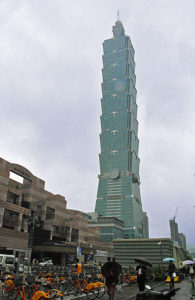
Taipei 101 in Taipei, Taiwan (Photo by Don Knebel)
Named for its 101 stories, Taipei 101 was completed in 2004 at a cost of almost two billion U.S. dollars. At 1671 feet (509 meters) tall, it was the first inhabited building more than half-a-kilometer high and was 188 feet taller than the Petronas Twin Towers in Kuala Lumpur, then the world’s tallest building. Taipei 101 lost its title in 2009 to Dubai’s 2,722-foot-high Burj Khalif, the first building more than half a mile tall. It retains its title as the world’s tallest green building, based on a LEED certification in 2011.
Taipei 101 is located about 660 feet from a major fault line. To withstand both a 2500-year earthquake and the typhoons common to Taiwan, the building includes a novel mechanism allowing the building to flex while resisting excessive swaying. A 728-ton spherical steel pendulum, 18 feet in diameter, is suspended between the 92nd and 87th floors and acts as a tuned mass damper, making the building stable even in 130-mile-an-hour winds.
The design of Taipei 101 symbolically celebrates Taiwan’s economic and technological progress. The number of floors – 101 – connotes both the new beginnings of each January 1 and binary code. The exterior of the building, covered in green glass, suggests a giant bamboo stalk, an ancient icon of learning and abundance. Eight sections above the base each include eight floors, reflecting the number eight as a symbol of prosperity. Each section resembles an antique Chinese moneybox, a connection made explicit by circular projections on each side based on Chinese coins having a hole in their centers. At night, Taipei 101’s pinnacle is lighted yellow as a candle of liberty. When visiting Taipei, Taipei 101 is a must-see.
Comments are closed.